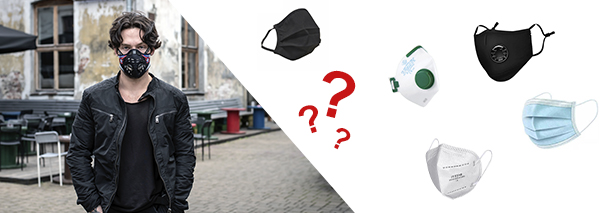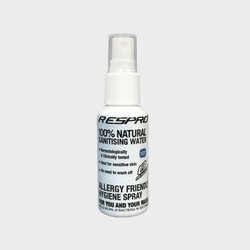Masks - How to get to grips with it?

FFP1/FFP2/FFP3 - How to get caught up in it?
There has been a tremendous amount of news hype recently regarding filter mask recommendations. Again, there have been a lot of articles, more or less overlapping with the truth. All of this has been compounded by the dishonest actions of companies offering all sorts of face shields including masks with "FFP2, FFP3 and even FFP2.5 filters".
How to make a name for yourself and how to buy a good quality mask with a real guarantee of protection?"
Here are some key tips that can come in handy when making an informed purchase.
Tip 1: Filter material is not a mask
It is important to remember that a mask is a combination of filter material, coating, attachment straps and valves. Simply applying a filter to the face does not protect against anything. Protection is only provided by a properly designed and manufactured combination of all elements. Therefore, filtering material alone (even of the highest quality) does not guarantee protection. To put it figuratively, putting a "veil" made of non-woven filtering material on our head, even of FFP3 filtration class, does not protect us in a proper way, just as a visor does not protect us.
A frequent practice used by dishonest sellers is the use of nomenclature such as FFP1, FFP2, FFP3 or even the non-existent FFP 2.5 class for their masks, which have not undergone testing culminating in the issuance of a Declaration of Conformity and an EU Type Testing Certificate. In many cases, the providers present the test results of the filter material itself on their websites. Please note, however, that this in no way constitutes a guarantee of protection. The results of such selective tests show a higher level of filtration, as they do not take into account the various types of leakage occurring at the mask-face interface.
The obtaining of an EU Type Test Certificate is preceded by more than 100 different tests. The details of these tests are described in standard EN 149:2001+A1:2009. This is a demanding and costly undertaking, but one that allows you to "sift the wheat from the chaff". Even masks with a lower, but guaranteed protection class FFP1 according to EN149: 2001+A1:2009 (filtration above 80%) are better than those for which we do not have such knowledge. Failure to perform certification may indicate a lack of confidence in the capabilities of one's own product or the use of unjustified economies.
Tip 2: Request a Declaration of Conformity from the seller
Declaration of Conformity is a formal document issued by the manufacturer confirming that the mask complies with European Parliament Regulation 2016/425 of 9.03.2016, setting out the requirements for personal protective equipment and the EN 149:2001 + A1:2009 standard. Such a document should be attached to the products sold and/or made available on the website. More on this topic can be found here.
A sample declaration, for Respro masks is available here.
Please note that this is not a clipping report (e.g. filter material) but a formal document of this nature.
Tip 3: Check that the mask has the required markings
The filter mask should have the required markings including in particular the CE mark, protection class and others. The marking requirements and their description can be found under the following link.
Tip 4: Check the validity of the CE certificate.
The right to mark a mask with the CE mark must be preceded by a so-called EU type examination, on the basis of which an EU type examination certificate is issued by a notified body authorised for such activities. There are 2 such bodies in Poland:
- Polish Register of Shipping (PRS),
- Central Institute for Labour Protection (CIOP).
Providing the Certificate is not mandatory, but shows the goodwill and full transparency of the seller or manufacturer (this is the case in the case of Respro)
However, even in the absence of the availability of such a document, we can refer to the mandatory Declaration of Conformity, which should include the name of the testing institution and the certificate number. With this information we can verify the validity of the certificate, for example:
- Certificates issued by PRS -on
- Certificates issued by CIOP -on
Radio 5: The higher the protection class the worse the breathing conditions
When selecting a mask, it is important to remember an extremely important relationship: the higher the protection class, the higher the breathing resistance. Below is a table showing this relationship.

For N95 masks the allowable resistance is 343 Pa (!!!).
Therefore, when making a choice, be aware that ease of breathing is of considerable importance during movement.
Radio 6: FFP1/2/3 mask or surgical mask
Without going into detail, it is important to remember their different purpose and resulting design. Surgical masks are primarily designed to protect the patient from infection by the surgeon on the operating table. In a hospital setting, their operation is assisted by specialised ventilators. However, surgical masks do not fit tightly to the face and therefore do not protect their wearers. In the case of 'FFP masks', the purpose of use is the opposite, i.e. they are primarily intended to protect those using them.
Rad 7: N95 and N99 masks are subjected to less demanding testing than FFP1/2/3 masks
The American standard setting out the requirements for N95 and N99 respirators is less stringent than its EU equivalent EN 149:2001+A1:2009. In particular, this applies to the testing of the filtration level. For N95 and N99 masks, such testing is based on particulate matter (sodium chloride - NaCl). For masks tested to EU standards, the filtration of liquid particles, specifically paraffin oil, is additionally tested. Obtaining good results for such a medium is much more difficult. In our opinion, masks with protection class FFP1 have parameters like those of N95 masks. N95 and N99 masks also have a much higher permissible breathing resistance, as we wrote above, and they do not test for CO2 content in the mask.
Tip 8: Reusable masks maintain a level of protection for days
In the case of reusable masks having an additional letter R next to the description of the protection class (such a mask is Respro, among others, which has a FFP1 R class), the level of protection is maintained for many days. In the case of disposable masks (FFP2 NR or FFP3 NR) and masks N95, N99, KN 95, KN 99, they should be discarded after each use and the maximum duration of use should not exceed 8 hours. Such masks have not been tested for this circumstance and therefore we do not know what happens e.g. to the filtration level if this time is exceeded or if they are used repeatedly.


